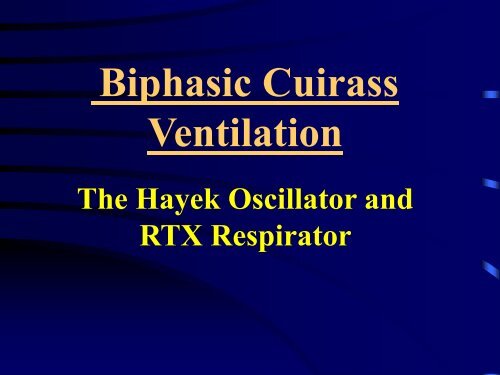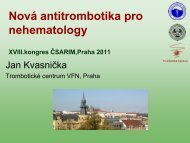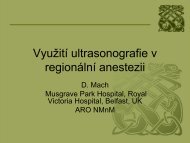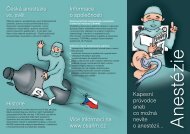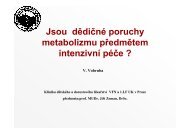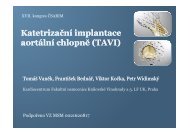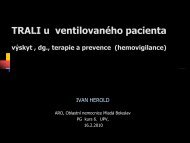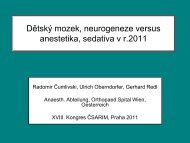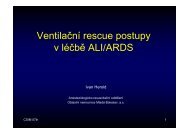Biphasic Cuirass Ventilation
Biphasic Cuirass Ventilation
Biphasic Cuirass Ventilation
You also want an ePaper? Increase the reach of your titles
YUMPU automatically turns print PDFs into web optimized ePapers that Google loves.
Title slide<br />
<strong>Biphasic</strong> <strong>Cuirass</strong><br />
<strong>Ventilation</strong><br />
The Hayek Oscillator and<br />
RTX Respirator
BCV Summary<br />
-<strong>Biphasic</strong> <strong>Cuirass</strong> <strong>Ventilation</strong> (BCV) is often the ideal<br />
ventilator as it:<br />
a) Provides complete ventilation to patient<br />
b) Is non-invasive<br />
c) Works in a physiological way, in that it:<br />
i) works in the way that the lungs work most efficiently by<br />
actively controlling both phases of the respiratory cycle<br />
ii) Provides even ventilation for patient<br />
iii) Helps to maintain and redevelop the respiratory muscles<br />
which often wither and waste with respiratory failure and<br />
mechanical ventilation<br />
iv) Improves cardiac output
BCV Summary<br />
-<strong>Biphasic</strong> <strong>Cuirass</strong> <strong>Ventilation</strong> (BCV) is often the ideal<br />
ventilator as it:<br />
d) Provides an efficient method of weaning from PPV<br />
e) Assists patient to remove secretions which are a symptom<br />
of most respiratory diseases, aggravating the condition of<br />
these patients<br />
f) Can begin to provide treatment for patients before their<br />
condition deteriorates and hospitalisation is required<br />
g) Allows for continuity of treatment for patients in hospital,<br />
at home, in transport and in emergency situations<br />
h) Is simple to use and comfortable for the patient
BCV Summary 2<br />
-Although BCV uses a cuirass, and has an active<br />
negative phase<br />
BCV IS NOT NEGATIVE PRESSURE VENTILATION<br />
-Although BCV has an active positive phase,<br />
BCV IS NOT POSITIVE PRESSURE VENTILATION<br />
-BCV is external, controls both respiratory phases<br />
actively, can work at low and high frequencies and<br />
generally keeps the benefits of the differing types<br />
of mechanical ventilation whilst avoiding most of<br />
their disadvantages
Treating Respiratory Failure –<br />
Mechanical <strong>Ventilation</strong><br />
The Ideal Ventilator (1):<br />
• Should replicate the spontaneous breathing<br />
pattern while achieving adequate ventilation<br />
• Should be non-invasive<br />
• Should preserve the normal intrathoracic<br />
pressure and whilst not compromising<br />
circulation<br />
(Cont.)
Treating Respiratory Failure –<br />
Mechanical <strong>Ventilation</strong><br />
The Ideal Ventilator (2):<br />
• Should facilitate the clearance of secretions<br />
• Should be therapeutic in maintaining or<br />
improving the patient‟s condition (e.g.<br />
maintaining the respiratory muscles)<br />
• Should be user friendly to:<br />
a) the patient, in terms of comfort<br />
b) the operator, in terms of ease of use
Negative Pressure <strong>Ventilation</strong><br />
Iron Lung<br />
(1843)<br />
The First Workable Iron Lung<br />
(1847)<br />
The Motorized Iron Lung<br />
(Late 1920‟s)<br />
Dalziel<br />
Woillez<br />
Drinker &<br />
Emerson<br />
First <strong>Cuirass</strong> NPV<br />
Drinker<br />
(1939) & Collins
Negative Pressure <strong>Ventilation</strong><br />
Woillez‟s “Spirophore”<br />
(1876)<br />
Breuillard‟s<br />
“BathCabinetRespirator”<br />
(1877)
Negative Pressure <strong>Ventilation</strong><br />
Inspiratory active (chest inflation to above FRC)<br />
Expiratory passive (passive chest recoil to FRC)
Tank Ventilators/The Iron<br />
Although tank ventilators are effective in normal<br />
lungs, they are far less effective in sick lungs. The<br />
disadvantages of the Iron Lung include:<br />
• They are cumbersome<br />
Lung<br />
• Limited access to patients<br />
• Aggravated heart failure as it:<br />
a) Reduced venous return<br />
b) Increased afterload<br />
c) Could worsen pulmonary edema<br />
• Could not use higher pressures or frequencies
Negative Pressure <strong>Cuirass</strong><br />
Ventilators<br />
Although cuirass negative pressure devices had<br />
advantages over the tank in that they were easy to<br />
use, were less cumbersome (whilst still covering the<br />
chest and abdomen) and actually improved venous<br />
return, there were severe disadvantages using this<br />
method as:<br />
• This method could not provide adequate tidal<br />
volume or minute ventilation<br />
• Could still not use higher pressures or frequencies<br />
as still relied on passive recoil<br />
• Therefore this method was by definition only an<br />
augmenting type of ventilation
The Pneumobelt<br />
The pneumobelt functions by exerting<br />
pressure on the abdominal contents by<br />
inflation of a rubber bladder, forcing the<br />
diaphragm upward and assisting exhalation<br />
(left). When the bladder deflates, gravity<br />
pulls the diaphragm back down, assisting<br />
inhalation (right).<br />
Robert M. Kacmarek, “Home Mechanical <strong>Ventilation</strong> Equipment” in Respiratory Care Equipment<br />
2nd Edition, Branson et al (New York: Lippincott, 1999)
The Rocking<br />
Bed
Zidulka et al 1983 Am. R&V<br />
CHEST WALL COMPRESSION<br />
Expiratory active (Chest compression to below FRC)<br />
Inspiratory passive (Chest recoil to almost FRC)
Bi-Phasic <strong>Cuirass</strong><br />
<strong>Ventilation</strong> (BCV)<br />
„The Hayek Oscillator‟<br />
(The H.O.)
Unification of Terms:<br />
The method of ventilation of the H.O. and the RTX<br />
which we are describing has been labelled in several<br />
different ways:<br />
Negative Pressure <strong>Ventilation</strong> (NPV)<br />
External Chest Wall Oscillation (ECWO)<br />
External High Frequency Oscillation (EHFO)<br />
However, the most accurate and preferable<br />
way to describe this method is:<br />
<strong>Biphasic</strong> <strong>Cuirass</strong> <strong>Ventilation</strong> (BCV)
Negative Pressure <strong>Ventilation</strong><br />
+<br />
+ BCV<br />
Zidulka Chest Wall Compression + Pneumobelt
BCV (EHFO) AROUND ATMOSPHERIC PRESSURE WITH H.O.
EHFO AROUND NEGATIVE BASELINE
EHFO around negative baseline in a condition of reduced<br />
FRC<br />
By creating negative end expiratory chamber pressure, lung volume at<br />
expiration is above initial FRC
12<br />
An increase in Mean (MNCP) leads to an increase<br />
in Lung Volume (VL)<br />
Lung Volume (VL) ml/kg<br />
10<br />
8<br />
6<br />
4<br />
2<br />
0<br />
-6 -10 -14<br />
Mean Negative Chamber Pressure (MNCP) cmH2O
PaO2<br />
250<br />
An increase in Mean (MNCP) leads to an increase<br />
in PaO2<br />
200<br />
150<br />
100<br />
50<br />
0<br />
-6 -10 -14<br />
Mean Negative Chamber Pressure (MNCP) cm H2O
12<br />
An increase in amplitude (span) leads to an<br />
increase in tidal volume (Vt)<br />
Vt (Tidal Volume) ml/kg<br />
10<br />
8<br />
6<br />
4<br />
2<br />
0<br />
6 8 10 14<br />
Span (cm H2O)
PaCO2<br />
30<br />
An increase in amplitude (span) leads to a<br />
decrease in PaCO2<br />
25<br />
20<br />
15<br />
10<br />
5<br />
0<br />
6 8 10 14<br />
Span (cm H2O)
External High Frequency Oscillation Around Negative Baseline<br />
- Preliminary Trials in Humans<br />
Hayek Z., Schonfeld T.<br />
Pediatric Intensive Care Unit, Beilinson Medical Centre, Sackler Faculty of Medicine,<br />
Tel Aviv University, Israel<br />
Ventilated five pediatric patients: (1) Heart failure and pneumonia (2)<br />
Hypoventilation (3) Bronchiolitis Obliterans (COPD) (4) Bronchiolitis and<br />
Pneumonia (5) Ataxia Telangectasia, Bronchiectasis and Restrictive<br />
Pulmonary Disease<br />
"This preliminary trial proved that patients with different lung<br />
diseases can be ventilated effectively with External High<br />
Frequency Oscillation around a Negative Baseline, while<br />
completely avoiding intubation and positive pressure<br />
ventilation."<br />
Excerpta Medica 1990, pages 761-762, Proceedings of the 5 th World Congress on Intensive and Critical Care<br />
Medicine, Kyoto, 3-8 September 1989
Acute Respiratory Failure (Paediatrics and<br />
Adults)
Hayek Oscillator; Experience in Intensive Care<br />
J.M. Campbell and M. Nevin<br />
Bristol Royal Infirmary<br />
In this study the HO has been used in two groups of patients in a general intensive care unit (ICU).<br />
Group 1 - acute deceleration injury induced adult respiratory distress syndrome (ARDS) in patients who had<br />
reached the criteria for extra-corporeal membrane oxygenation were commenced on the Hayek Oscillator, in<br />
addition to their pressure control ventilation (PCV), with rapid improvement in their blood gases. "In all three cases<br />
this resulted in a significant decrease in ICU time compared to controls."<br />
In Group 2 - the Hayek Oscillator was introduced to either hasten weaning from IPPV or prevent ventilation. "In<br />
four of the six patients this was successful with X-ray as well as clinical improvement and a reduction in ICU stay.“<br />
Clinical Intensive Care Supplement to Volume 4, No. 2, 1993
The Combination of External High-Frequency Oscillation<br />
and Pressure Support <strong>Ventilation</strong><br />
in Acute Respiratory Failure<br />
S. Takeda, K. Nakanishi, T. Takano, J. Nejima, M. Takayama, G. Ishikawa 2 and R. Ogawa 1<br />
Department of Intensive Care Medicine and 1 Anaesthesiology<br />
Nippon Medical School, Tokyo, Japan<br />
Results: Significant increases were noted in cardiac index (3.0 + 0.7 to 3.2 + 0.7 1 . min –1 . m<br />
–2<br />
, P
Chest Wall Oscillation in Acute Respiratory Failure Utilizing the Hayek Oscillator<br />
M.R. Bennett, M.D., K.E. Blair, RRT, P.C. Fiehler, M.D., L.R. Kline, M.D.<br />
Division of pulmonary Medicine, The Western Pennsylvania Hospital, Pittsburgh<br />
"Nine consecutive patients in acute respiratory failure (ARF) were ventilated non-invasively using the Hayek<br />
Oscillator. The frequencies used were confined to at or below the current FDA approved rates of 60 cycles/minute<br />
(1 Hz). Three patients (33%) were complete responders, demonstrating a reduction in Pco 2<br />
, an increase in<br />
oxygenation and improved overall appearance. All members of this class avoided conventional mechanical<br />
ventilation (CMV) and were the only patients in this study to survive the hospital stay. Three others were classified<br />
as partial responders. The Hayek Oscillator allowed non-invasive stabilization of this group while deciding on<br />
future care options. Three other patients in the non-responding group failed to tolerate the chest cuirass.<br />
We conclude that the Hayek Oscillator, at frequencies up to 1<br />
Hz, is capable of providing adequate ventilation in a subset of<br />
patients in ARF, avoiding or delaying tracheal intubation.<br />
This was accomplished in a manner that was non-invasive,<br />
safe and comfortable."<br />
American Review of Respiratory Disease International Conference Supplement, Volume 147, Number 4,<br />
April 1993
External High Frequency Oscillation in Normal Subjects and in Patients with Acute<br />
Respiratory Failure<br />
Al-Saady NM, Fernando SS, Petros AJ, Cumin AR, Sidhu VS and Bennett ED<br />
Department of Medicine, St. George's Hospital Medical School, London<br />
External high Frequency oscillation was performed on 20 healthy volunteers using a cuirassbased<br />
system, the Hayek Oscillator. Five-min periods of oscillation were carried out on each subject at<br />
frequencies of !,2, 3, 4 and 5 Hz. Effective ventilation was measured in terms of the fall in alveolar partial<br />
pressure of carbon dioxide immediately after oscillation. The optimum frequency for oscillation<br />
was 1-3 Hz but most of the subjects were adequately ventilated over a wide range of frequencies. Thus, the<br />
Hayek Oscillator is capable of adequately ventilating normal subjects by means of chest wall oscillation.<br />
We also compared external high frequency oscillation with intermittent positive<br />
pressure ventilation in five patients with respiratory failure. Using the same<br />
inspired oxygen fraction, the external high frequency oscillation replaced<br />
intermittent positive pressure ventilation for a 30-min period. External high<br />
frequency oscillation improved oxygenation by 16% and reduced the arterial<br />
carbon dioxide by 6%. These preliminary findings suggest that normal subjects<br />
and intensive care unit patients can be adequately ventilated by means of external<br />
high frequency oscillation.<br />
Anaesthesia 50 (12): 103 -5, December 1995
Severe Tracheal Stenosis and Operative Delivery<br />
Sutcliffe N, Remington SA, Ramsay TM, Mason C<br />
Stepping Hill Hospital, Poplar Grove, Stockport, UK<br />
We report the management of anaesthesia for Caesarean section in a<br />
woman with severe extensive tracheal stenosis. Management was initially<br />
with spinal anaesthesis, but general anaesthesis became necessary as a<br />
result of profuse intra-operative bleeding. We describe the use of the<br />
Hayek Oscillator cuirass ventilator to allow instrumentation of the larynx<br />
whilst maintaining respiratory support, and for weaning from mechanical<br />
ventilation.<br />
Anaesthesia 50 (1): 26-9, January 1995
Chronic Lung Disease, COPD, Weaning and<br />
Secretion Clearance
External High Frequency <strong>Ventilation</strong> in Severe Chronic Obstructive<br />
Pulmonary Disease<br />
S.A. Spitzer, M.D., F.C.C.P.; G. Fink, M.D.; and M. Mittelman, M.D.<br />
Study Group: 20 patients with severe chronic obstructive pulmonary disease (COPD). 10<br />
were eucapnic and 10 were hypercapnic. Frequencies from 60 to 140 cycles/min at an<br />
amplitude of 36 cmH 2<br />
O (-26 to +10).<br />
The results show: "that the [Hayek Oscillator] is a powerful ventilator, reducing end-tidal Pco 2<br />
(PetCO 2<br />
) by 6.7 to<br />
9.1 mm Hg in eucapnic patients and by 6.1 to 7.9 mm Hg in hypercapnic patients. The oxygen saturation<br />
increased by 2 to 2.87 percent in the eucapnic patients and by 2.6 to 3.7 percent in the hypercapnic group in the<br />
various frequencies. The rate of elimination of CO 2<br />
and the levels of PetCO 2<br />
achieved within a short time were<br />
superior to those reported with other external ventilators.<br />
We conclude that the [Hayek Oscillator] can be effectively used in severe COPD<br />
and respiratory failure for (1) assisting ventilation, thus replacing intubation and<br />
conventional mechanical ventilation, and (2) relieving muscle fatigue in short<br />
sessions.<br />
CHEST Vol. 104, p. 1698-1701, December 1993
Effects of External Chest Wall Oscillation in Stable COPD Patients<br />
G.W. Soo Hoo, M.J. Ellison, C. Zhang, A.J. Williams, M.J. Belman,<br />
Los Angeles VAMC and Cedars-Sinai Medical Center; UCLA School of Medicine,<br />
Los Angeles, California<br />
The effects of ECWO (using the Hayek Oscillator) were evaluated in four stable male patients with<br />
severe COPD. They were studied during quiet breathing (control) and during ECWO at<br />
frequencies of 30, 60 and 90 bpm. Best CO 2<br />
elimination was at 90 bpm. They found that<br />
"patients tolerated ECWO with reduction in ETCO 2<br />
and maintenance of oxygenation despite smaller<br />
VT.<br />
This experience suggests that ECWO would be an acceptable and<br />
effective alternative mode of non-invasive ventilatory support in COPD<br />
patients."<br />
American Journal of Respiratory and Critical Care Medicine Vol. 149, No. 4, April 1994
External High Frequency <strong>Ventilation</strong> for Weaning from Mechanical <strong>Ventilation</strong><br />
Gaitini MD*, Krimerman MD*, Smorgik MD**, Gruber MD**, Varzberger MD***<br />
*Intensive Care Unit, Bnei Zion Hospital, Haifa, **Bikur Holim Hospital, Jerusalem;<br />
***Meir Hospital, Kfar Saba, Israel<br />
"We present three cases in which the Hayek Oscillator was used in weaning patients who became dependent on<br />
C.M.V. and difficult to wean. Reventilation could be achieved within seconds, without the need for intubation and<br />
without hazard to the patient. Therefore, using the Hayek Oscillator, arrest of ventilation was easily decided on. A<br />
further advantage was a spontaneous mucus expulsion, each time the Hayek Oscillator was applied. External<br />
ventilation allowed easy and early weaning. Hazards of reintubation [were] eliminated and the period of<br />
ventilation and hospitalization reduced. The technique is noninvasive, well tolerated and costs less."<br />
Recent Advances in Anaesthesia, Pain, Intensive Care and Emergency 5, 1990, Pages 137-138
High Frequency Oscillation as Adjuvant Pneumonia Therapy in Severe Head Injury<br />
Dr. David Burns and Dr. Wayne Johnson<br />
University of California, San Diego<br />
"Pneumonia is a frequent, detrimental complication in severe head injury (SHI). Since chest physiotherapy (CPT)<br />
is often poorly tolerated in SHI, we have investigated the utility of the Hayek High Frequency Chest Wall<br />
Oscillation (CWO) in this setting. Vital signs remained stable during CWO, with no change in pulse, a mild (4<br />
mmHg) increase in mean arterial pressure, and
Use in Surgery and Post-Surgery
The Hayek Oscillator: A New Method of <strong>Ventilation</strong> in Microlaryngeal<br />
Surgery<br />
Michael G. Dilkes, FRCS (Ed), FRCS et al.<br />
ENT Department and the Department of Anaesthesia, Royal London Hospital,<br />
London<br />
Study Group: 25 patients, 25 to 75 years of age, all of whom required upper airway<br />
endoscopy.<br />
Conclusion: The "study has shown that the Hayek Oscillator appeared to provide<br />
adequate ventilation in anesthetized, paralyzed patients without endotracheal<br />
intubation, allowing us to perform unobstructed, unhurried microlaryngeal<br />
surgery in all cases.<br />
Annals of Otology & Laryngology June 1993, Volume 102, Number 6, pages 455-458
Use of the Hayek Oscillator in a Case of Failed Fibreoptic Intubation<br />
Broomhead CJ, Dilkes MG, Monks PS<br />
Department of Anaesthetics, Royal London Hospital Trust , Whitechapel, London<br />
We describe the management of a patient with predicted difficult tracheal intubation after failed<br />
awake fibreoptic intubation. Anaesthesia was induced with propofol and ventilation controlled by<br />
means of the Hayek Oscillator, a high frequency cuirass ventilator, without tracheal intubation. The<br />
patient underwent uneventful laser debulking of his massive pharyngeal tumour to establish a clear<br />
airway.<br />
British Journal of Anaesthesia Vol74(6): 720-1, June 1995
Anaesthesia for endescopic, laser, laryngeal and airway surgery using the<br />
Hayek Oscillator and total intravenous anaesthesia<br />
P.S. Monks and M.G. Dilkes<br />
Minimally Invasive Therapy 1995: 4 (Suppl 2): 27-30<br />
“Over 130 patients requiring laser surgery or endoscopic<br />
laryngeal surgery have been ventilated using the Hayek<br />
Oscillator”<br />
“External High Frequency Oscillation around a negative<br />
pressure baseline provides a satisfactory alternative to current<br />
methods of ventilating patients undergoing endoscopic<br />
laryngeal, or other airway surgery, e.g. tonsillectomy”
External High-Frequency Oscillation for Hypercapnia<br />
after Upper Abdominal Surgery<br />
Shinhiro Takeda 1 , Kazuhiro Nakanishi 1 , Teruo Takano 1 , Jun Nejima 1 , Morimasa Takayama 1 ,<br />
Atsuhiro Sakamoto 2 and Ryo Ogawa 2<br />
1<br />
Division of Intensive Care and Coronary Care Unit and 2 Department of Anaesthesiology<br />
Nippon Medical School, Tokyo, Japan<br />
Seven patients were ventilated with EHFO for 2 hr at 60 oscillations/min, with cuirass<br />
pressures of 36 cm H 2<br />
O (-26 to +10), and an inspiratory to expiratory ratio of 1:1. Blood gases and<br />
cardiac functional parameters were examined during the 2 hr on EHFO.<br />
PaCO 2<br />
significantly decreased from 61+8 mm Hg to 48+7 mm Hg after 10 min on<br />
EHFO (p
The Use of the Hayek Oscillator to Produce Postoperative Hyperventilation<br />
in the Neurosurgical Patient<br />
Dr. A. Bristow FFARCS<br />
Consultant Anaesthetist, St. Bartholomews Hospital, London<br />
Twelve ASA I patients undergoing elective craniotomy were given a standardised anaesthetic.<br />
Immediately after extubation at the end of the operation, the [Hayek] Oscillator was attached to the<br />
patients.<br />
There was a significant rise in PaO 2<br />
and a significant reduction in PaCO 2<br />
to the range 3.3 -4KPa. There were no signs of airway obstruction, and all<br />
patients found the Oscillator comfortable.<br />
Neuroanaesthetists Travelling Club of Great Britain and Ireland The Medical School,<br />
Newcastle upon Tyne, Saturday 3 rd April, 1993
The Use of the Hayek Oscillator during Microlaryngeal Surgery<br />
Monks PS, Broomhead CJ, Dilkes MG, McKelvie P<br />
Nuffield Department of Anaesthetics, John Radcliffe Hospital, Headington,<br />
Oxford, UK<br />
An externally mounted cuirass ventilator, the Hayek Oscillator, was used on 41<br />
patients undergoing surgery to the larynx without the use of tracheal tube. Gas<br />
exchange and cardiovascular parameters remained satisfactory during the use<br />
of this technique, which offers a significant advance over existing tubeless<br />
methods of anaesthesia.<br />
Anaesthesia 50(10): 865-9, October 1995
Effect on Cardiac Performance
The Effects of Positive and Negative Extrathoracic Pressure <strong>Ventilation</strong><br />
on Pulmonary Blood Flow<br />
after the Total Cavopulmonary Shunt Procedure<br />
D.J. Penny, Z. Hayek and A.N. Redington<br />
Department of Paediatric Cardiology, Royal Brompton and National Heart<br />
Hospital, London<br />
"Pulmonary blood flow patterns were studied during the application of varying<br />
extrathoracic pressure in 2 patients after total cavopulmonary anastomosis. The<br />
application of negative extrathoracic pressure [by use of the Hayek<br />
Oscillator] was associated with large increases in pulmonary<br />
blood flow, while positive extrathoracic pressure caused<br />
retrograde flow away from the lungs. These preliminary<br />
observations suggest that negative extrathoracic pressure<br />
may be useful as a means of respiratory support in patients<br />
after right heart bypass procedures."<br />
International Journal of Cardiology, 30 (1991) 128-130
<strong>Ventilation</strong> with External High Frequency Oscillation around a<br />
Negative Baseline increases Pulmonary Blood Flow after the<br />
Fontan Operation<br />
D.J. Penny, Z. Hayek, P. Rawle, M.L. Rigby and A.N. Redington<br />
Department of Paediatric Cardiology, Royal Brompton and National Heart Hospital, London<br />
"When compared to that with intermittent positive pressure<br />
ventilation, ventilation using external high frequency<br />
oscillation increased pulmonary blood flow by<br />
116+61.5%(p=0.013)."<br />
"In summary, these data suggest that ventilation using a<br />
cuirass device to provide a negative oscillatory pressure will<br />
make a significant contribution to the post-operative care of<br />
patients who require respiratory support after the Fontan<br />
operation."<br />
Cardiol Young 1992; 2:277-280
FONTAN OPERATION (Study 2)<br />
Methods(1)<br />
______________________________________________________________________<br />
All studied under general anaesthesia and paralysis<br />
Ventilated using intermittent positive pressure ventilation<br />
Ventilated using a Hayek Oscillator<br />
- negative pressure baseline (mean -8.5 mmHg)<br />
End-tidal CO2 and arterial PO2 maintained constant
FONTAN OPERATION (Study 2)<br />
Results<br />
______________________________________________________________________<br />
Oscillator/<br />
IPPV (%)<br />
P Value<br />
Heart rate<br />
Forward flow/cycle<br />
Retrograde Flow/cycle<br />
Nett forward/cycle<br />
Nett forward/min<br />
97%<br />
198 + 68%<br />
85 +17%<br />
228 +85%<br />
216 +65%<br />
NS<br />
0.022<br />
NS<br />
0.017<br />
0.013
Negative-pressure <strong>Ventilation</strong> Improves Cardiac Output after Right Heart Surgery<br />
L.S. Shekerdemian, D.F. Shore, C. Lincoln, A. Bush and A.N. Redington<br />
Department of Paediatrics Royal Brompton Hospital, London, UK<br />
"BACKGROUND: A low cardiac output state can complicate the postoperative course of patients undergoing<br />
fontan-type operations and tetralogy of Fallot repair.<br />
METHODS AND RESULTS: "We investigated the effect of negative-pressure ventilation on<br />
cardiac output in 11 children in the early postoperative period after right heart surgery. All<br />
patients were initially ventilated with volume-cycled intermittent positive-pressure ventilation, and negative<br />
pressure ventilation was delivered with the Hayek external high-frequency oscillator.…. improved the<br />
cardiac output by a mean of 46% (P=.005). Heart rate did not change, and<br />
stroke volume increased by a mean of 48.5% (P=.005).<br />
Mixed venous saturation increased by 4.6% (P
Cardiopulmonary Interactions after Fontan Operations<br />
Augmentation of Cardiac Output Using Negative Pressure <strong>Ventilation</strong><br />
L.S. Shekerdemian, A. Bush, D.F. Shore, C. Lincoln, and A.N. Redington<br />
Department of Paediatrics Royal Brompton Hospital, London, UK<br />
METHODS AND RESULTS: "The hemodynamic effects of conversion from conventional intermittent positive<br />
pressure ventilation (IPPV) to cuirass negative pressure ventilation (NPV) [Hayek Oscillator] was investigated<br />
in nine acute postoperative Fontan patients on the pediatric intensive care unit and nine<br />
anesthetized patents undergoing cardiac catheterization in the convalescent phase after<br />
Fontan operations….. A brief period of NPV increased pulmonary blood flow from 2.4 to<br />
3.5 L . min -1 . / m -2 with a mean increase of 42%. Pulmonary blood flow<br />
continued to improve, with a total increase of 54% after an extended period<br />
of NPV. Values fell toward baseline after reinstitution of IPPV. Heart rate was<br />
unchanged during NPV and the improvement in pulmonary blood flow was achieved by an increase in stroke<br />
volume from 25 mLm 2 to 37 mLm 2 .<br />
CONCLUSIONS: Through improvement of the stroke volume alone, NPV<br />
brought about a marked increase in the pulmonary blood flow and, hence,<br />
cardiac output of Fontan patients. An improvement in cardiac output of<br />
this order, and by this mechanism, is currently unmatched by any<br />
therapeutic alternatives."<br />
Circulation 1997:96: 3934-3942
Hemodynamic Effects of Different Modes of Mechanical <strong>Ventilation</strong> in Cardiac and Respiratory<br />
Failure: An Experimental Study<br />
G. Zobel*, D. Dacar** and S. Rodl*<br />
Department of Pediatrics* and Cardiac Surgery**, University of Graz, Austria<br />
Study was carried out on 12 pigs, to compare the hemodynamic effects of 4 different modes of Mechanical<br />
<strong>Ventilation</strong> in 3 stable conditions: normal, acute ventricular failure by -blocking agents and respiratory failure<br />
induced by repeated lung lavages. It was concluded that "ECG-triggered HFJV seems to have the best<br />
benefits on cardiac output during control conditions, whereas EOSC [the Hayek Oscillator] seems to<br />
have hemodynamic advantages in cardiac and respiratory failure conditions."<br />
Clinical Intensive Care Supplement to Vol. 4 No. 2 1993
Improved Oxygen Delivery by Positive Pressure<br />
<strong>Ventilation</strong> with Continuous Negative External Chest<br />
Pressure.<br />
Scholz S.E., Knothe C., Thiel A. and Hempelmann G.<br />
Higher positive end-expiratory pressures (PEEP) improve arterial pO2 by raising the tidal<br />
range above closing capacity, while decreasing cardiac output.<br />
5 critically ill patients on positive pressure ventilation with pre-existing PEEP exceeding 10 cm<br />
H2O were recruited into a two period cross-over trial. The effects of 4h of positive pressure<br />
ventilation with PEEP (CPPV-PEEP) were compared with positive pressure ventilation with<br />
continuous negative external chest pressure (CPPV-CNECP).<br />
The switch from (CPPV-PEEP) to (CPPV-CNECP) decreased mean airway pressure (19.9 vs<br />
14.3 cm H2O.<br />
Compared with CPPV-PEEP, the combination of positive-pressure ventilation<br />
with negative external chest pressure led to an increase in oxygen delivery<br />
because of an enhancement in cardiac index (mean 4.55 vs 6.40 L/min)<br />
The Lancet Saturday 3 May, 1997, Vol.349 No. 9061: 1295–1296
<strong>Ventilation</strong> by external high-frequency oscillations improves cardiac function after<br />
coronary artery bypass grafting<br />
B. Sideno, J. Vaage ,<br />
Department of Thoracic Surgery, Karolinska Hospital, Stockholm, Sweden<br />
Objective: To compare the effects of ventilation with intermittent positive pressure and external high frequency<br />
oscillation by the Hayek Oscillator during the first 5 h after coronary artery bypass grafting.<br />
Methods: Eleven patients were randomized to intermittent positive pressure ventilation throughout the<br />
observation period (5 h), while 13 patients were initially ventilated with intermittent positive pressure ventilation,<br />
then by external high-frequency oscillations for 4 h. changing to positive pressure ventilation for the last hour.<br />
Results: Cardiac index, stroke volume index, right ventricular stroke work index,<br />
right ventricular end-diastolic volume index and mixed venous oxygen saturation<br />
were significantly increased during ventilation with external high-frequency<br />
oscillations, and arteriovenous oxygen content difference was significantly<br />
reduced.<br />
Conclusions: "<strong>Ventilation</strong> by external high-frequency oscillations increases cardiac index and improves tissue<br />
perfusion….The Hayek Oscillator may have distinct cardiovascular benefits as ventilatory assistance in<br />
postoperative cardiac surgical patients."<br />
European Journal of Cardio-thoracic Surgery 11 (1997) 248-257
L * min -1 m2<br />
Cardiac Index<br />
EHFO<br />
IPPV<br />
3<br />
2<br />
1<br />
0<br />
1 2 3 4 5 6 7<br />
Time (Hours)
<strong>Biphasic</strong> Extrathoracic Pressure CPR<br />
A Human Pilot Study<br />
Howard A. Smithline et al.<br />
Department of Emergency Medicine, Henry Ford Health Systems, Henry<br />
Ford Hospital, Detroit<br />
"<strong>Biphasic</strong> Extrathoracic Pressure CPR [using the Hayek Oscillator] significantly<br />
increases the coronary perfusion pressure when compared with standard CPR<br />
[a pneumatic compression device (the Thumper)]. Additionally, there is a trend<br />
for improved systemic perfusion as indicated by the improved venous to arterial<br />
Pco 2<br />
gradient, although this is not reflected by significant decreases in the<br />
OER. Oxygenation and ventilation appear to be adequately maintained, thus<br />
obviating the need for positive pressure ventilation with its associated risks."<br />
CHEST Vol. 105, p. 842-846, March 1994.
Bi-Phasic <strong>Cuirass</strong><br />
<strong>Ventilation</strong> (BCV)<br />
„The RTX Respirator‟
BCV Summary<br />
-<strong>Biphasic</strong> <strong>Cuirass</strong> <strong>Ventilation</strong> (BCV) is often the ideal<br />
ventilator as it:<br />
a) Provides complete ventilation to patient<br />
b) Is non-invasive<br />
c) Works in a physiological way, in that it:<br />
i) Works in the way that the lungs work most efficiently by<br />
actively controlling both phases of the respiratory cycle<br />
ii) Provides even ventilation for patient<br />
iii) Helps to maintain and redevelop the respiratory muscles<br />
which often wither and waste with respiratory failure and<br />
mechanical ventilation<br />
iv) Improves cardiac output
BCV Summary<br />
-<strong>Biphasic</strong> <strong>Cuirass</strong> <strong>Ventilation</strong> (BCV) is often the ideal<br />
ventilator as it:<br />
d) Provides an efficient method of weaning from PPV<br />
e) Assists patient to remove secretions which are a symptom<br />
of most respiratory diseases, aggravating the condition of<br />
these patients<br />
f) Can begin to provide treatment for patients before their<br />
condition deteriorates and hospitalisation is required<br />
g) Allows for continuity of treatment for patients in hospital,<br />
at home, in transport and in emergency situations<br />
h) Is simple to use and comfortable for the patient
Coronary MRA with synchronised<br />
respiratory and cardiac motion using an<br />
external respirator reduces scan times and<br />
improves navigator efficiency<br />
S. Plein, T.N. Bloomer, J.P. Ridgway, T. Jones,<br />
Z. Hayek * , U.M. Sivananthan<br />
C A R D I A C<br />
L E E D S<br />
L E E D S<br />
M R<br />
Cardiac MRI Unit<br />
BHF Heart Research Centre<br />
Leeds General Infirmary, UK<br />
* Medivent Ltd. London, UK
Respiratory synchronisation<br />
• Modified RTX respirator* (Medivent, London, UK)<br />
• External respirator – no preparation required<br />
• Plastic cuirass, airtight seal, drive unit<br />
• Respiratory phases actively controlled by<br />
pressure change inside the cuirass:<br />
pressure: chest compression: expiration<br />
pressure: chest expansion: inspiration<br />
• Highly reproducible chest + diaphragm positions<br />
• ECG triggered mode: 1 full respiratory cycle per<br />
cardiac cycle.<br />
* S. Plein et al. Synchronising cardiac and respiratory motion with an external cuirass respirator.<br />
Poster 1834, ISMRM 2001
Tube<br />
Velcro straps<br />
<strong>Cuirass</strong><br />
Foam seal<br />
Pressure transducer
BCV - Advantages<br />
• No requirement for sedation<br />
• No risk of VAP<br />
• No risk of barotrauma<br />
• Increased patient comfort<br />
• Increase in cardiac output<br />
• Can be used in place of NI Mask, helmet etc<br />
• In most cases a direct replacement for IPPV<br />
• Management of secretions<br />
• Provides Physiotherapy and cough assistance<br />
• Decreased stay in ICU post operative
BCV Disadvantages<br />
• Can not be used on patients over 170kg<br />
• Requires a patent/viable airway<br />
• Can not be used on burns patients<br />
• Can not be used during surgery
Thank you<br />
• BCV – Available from Cheiron a.s.


